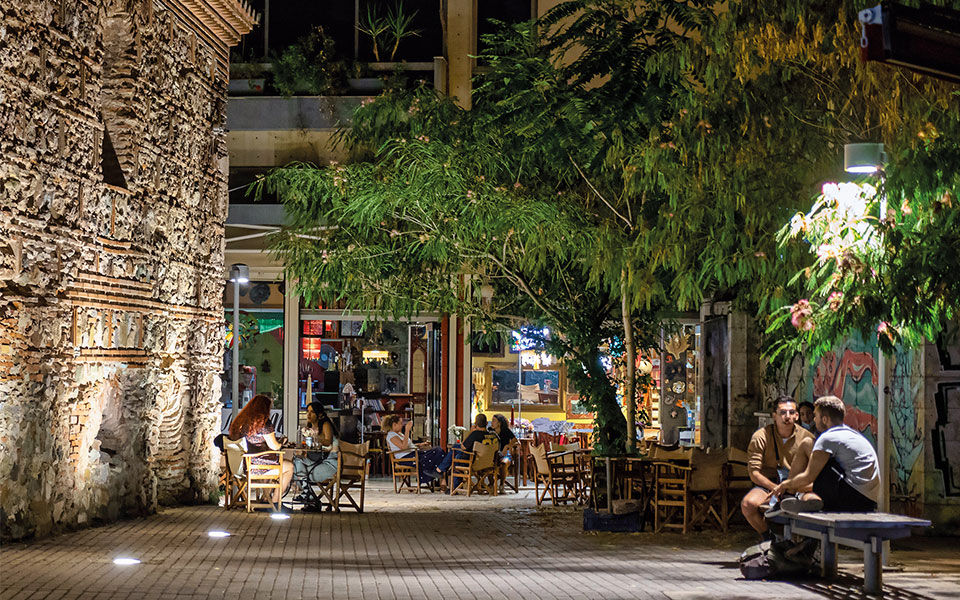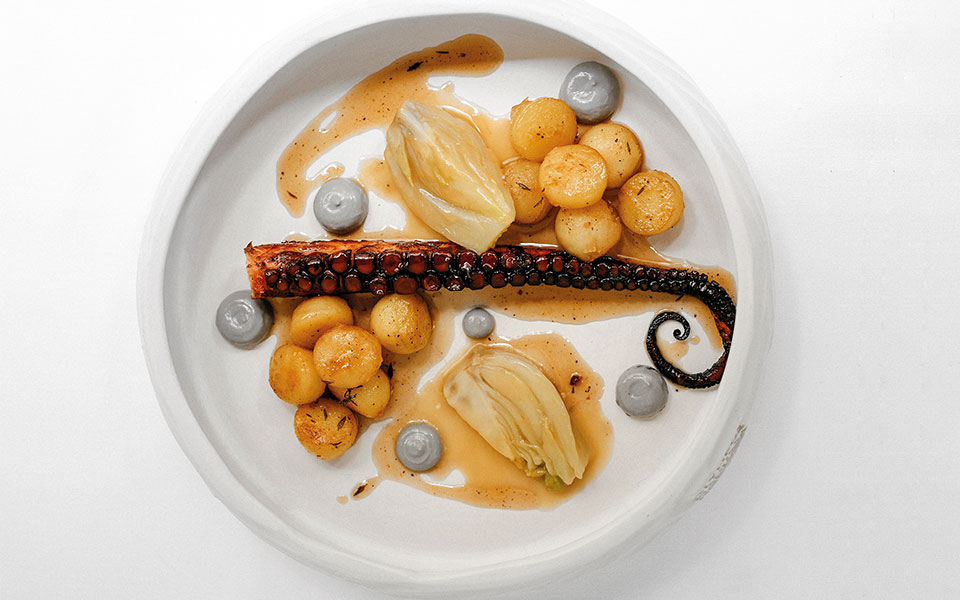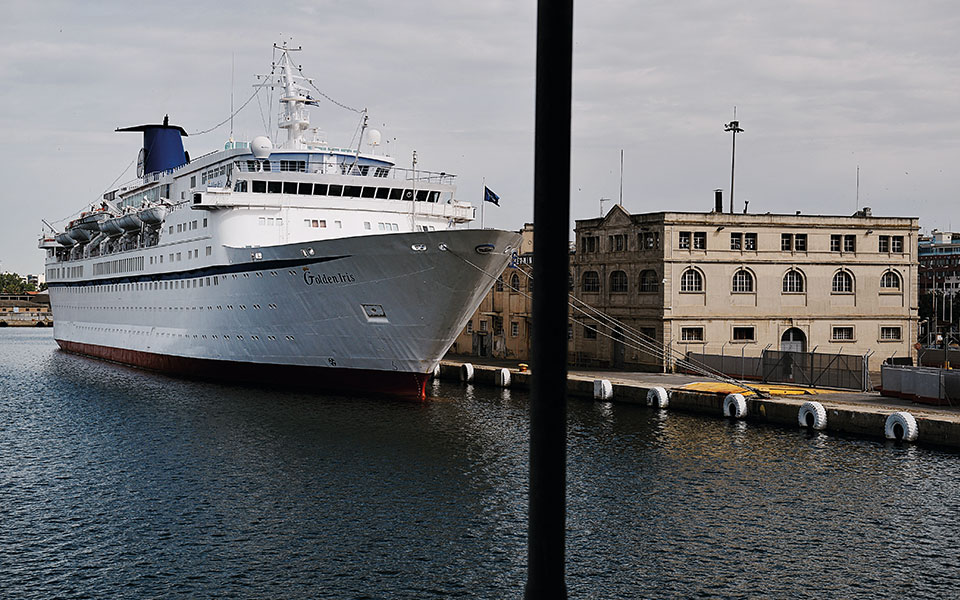A City in a Bite: Thessaloniki-Style Street Food
From postmodern bougatsa to wood-fired pizza...

© Konstantinos Tsakalidis
It’s the second week of November, and I’m taking an afternoon stroll around Ladadika, a historic district in downtown Thessaloniki that’s recently become a culinary hub, thanks to several new restaurants. There’s a light drizzle in the air and a great deal of buzz coming from the 63rd Thessaloniki International Film Festival. On cobbled Morichovou Square, I notice an English-speaking family of tourists making their plans over a map as I head towards Katouni Street, which has seen quite a few new arrivals, mostly bar-restaurants that play dance music. I make my way to a modern café, designed and run by Beetroot, on the corner of Syngrou and Valaoritou.
Beetroot is a multi-award-winning design firm, and it recently launched this venture, where it also sells its own merchandise, everything from posters to kitchen aprons. The place is self-service, so I join the line and wait to order. The women in front of me are talking in Hebrew about the wine list.

The city has a vibrant nightlife scene, thanks in part to its university students.
© Perikles Merakos
Just a decade ago, such scenes would have been unimaginable. The city had few foreign tourists, even from the Balkans, and fewer still during the colder months of winter. It was a little-known destination linked to the world by a handful of flights from abroad. During the 2010-2018 economic crisis, however, an interesting culinary scene emerged in Thessaloniki, with young chefs experimenting with local ingredients, reviving forgotten recipes from the city’s multicultural past, and serving excellent food at very reasonable prices. At the same time, the Israeli travel market took an interest in the city because of the large Jewish community that once thrived here. Investments in accommodation followed suit, albeit timidly at first. Landmark hotels were revamped, and new modern units were built, too. By 2019, when the city broke its arrivals record, Thessaloniki was firmly established as a pleasant, good-value weekend break destination.
Despite expectations, a new record in 2022 didn’t materialize. According to figures from the Institute of the Greek Tourism Federation, the city’s renovated Macedonia International Airport received 320,000 fewer visitors in January-October 2022 than it did in 2019. The drop in arrivals also appears to have affected overnight stays which, according to the Thessaloniki Hoteliers’ Association, were down 13.9% in the first nine months of the year compared with three years ago. As this was a particularly good year for tourism in Greece, the slump worries local stakeholders. “There’s an urgent need for a comprehensive strategic plan to develop the city’s tourism image and infrastructure and to attract visitors from new markets,” says Alexandros Mandrinos, president of the hoteliers’ association.

The relaunched Olympos Naoussa serves creative new takes on classics from the restaurant's original menu.
Despite concerns for the future, Thessaloniki continued to maintain the reputation it has built for itself over the past few years. Time Magazine put it on its list of the world’s top 50 destinations in 2022 for its culinary scene, which “has long attracted foodies.” It’s also the first Greek city to be inducted into UNESCO’s Creative Cities of Gastronomy network, rewarding efforts to showcase its rich and multifaceted cultural identity through food. Along with its modern kafeneios, traditional ouzeris, humble tavernas, restaurants experimenting with creative Greek cuisine and wine bars showcasing local producers and Macedonia’s wine country, new projects of a more far-reaching scope are also being developed.
Following the launch of Ergon Agora East – a seaside space on the eastern edge of the city dedicated to food and recreation and featuring a food hall, restaurants and bars – and the rebirth of the legendary restaurant Olympos Naoussa on Nikis Avenue, December 2022 saw what’s possibly the most significant opening in Thessaloniki in recent years. After 22 years of neglect that brought it close to collapse, the iconic Modiano Market celebrated its 100th anniversary by revealing its new look following a makeover that’s put it on a par with the best food halls in Europe. It now hosts more than 70 food shops specializing in local artisanal products, as well as restaurants, bars and an upper level with areas suitable for special events.
The Fais Group, which carried out the reconstruction and invested €10 million in the project, estimates that Modiano Market will welcome 4 million visitors in the first year alone, 25% of which will be from abroad. “We’re experiencing a burst of growth in the city right now, similar to that of the late 19th century. Its airport has been renovated and upgraded, improving connectivity with international destinations. The completion of road projects makes the city more accessible by car. The modernization of commercial rail routes and the development of the port will re-establish Thessaloniki as a hub of trade and commercial activity in the Balkan region,” says Hasdai Capon, general manager of the Fais Group.

Seventy cruise itineraries have already committed to the city for 2023; half of those will begin and end here.
© Giannis Papanikos/AFP/Visualhellas.gr
The continuing upgrade of the Thessaloniki Port has boosted commercial traffic and tourism. It now runs ferry services to several new destinations, including the nearby Sporades Islands and the more distant Cyclades, as well as a summer-season route to Izmir, which will strengthen ties with the Turkish market. It’s also helped Thessaloniki make a dynamic entry into the cruise market. Right now, the city is connected to 10 different ports (including Istanbul, Kusadasi, and Volos). In 2021, it was designated a “homeport,” meaning that cruises start and end here. Compared with 2019, cruises this year have increased tenfold since their February start date, the earliest ever. In 2022, there were 61 cruises stopping here; 70 have already been scheduled for 2023, with half being homeporting cruises. Most passengers are from the US, Canada, and the UK, but there are Greeks, too. Thessaloniki’s status as a trade and tourism hub was confirmed when it was picked to host next year’s installment of the top cruise and yachting conference, the Posidonia Sea Tourism Forum.
Conferences and exhibitions are another field of activity that brings tourists and money to the city. Along with the annual Thessaloniki International Fair, 2022 saw a second consecutive edition of BEYOND, an important technology and innovation fair, and of Agrotica, a major exhibition for agricultural machinery, tools and supplies; the latter attracted more than 110,000 visitors from Greece and abroad and is estimated to have injected €35 million into the local economy. “We’re fortunate,” says Prodromos Monastiridis, president of the Thessaloniki Convention Bureau, “that the city has a big exhibition center in the downtown area and two universities that organize numerous scientific conferences. Over the past five years, Thessaloniki has been making significant strides in terms of conferences. In 2021, it climbed 23 spots on the list of global conference destinations, according to the International Congress & Convention Association (ICCA), compared with 2019.”

Over the last eighteen months, four new five-star hotels have opened in the city, including the Teight.
Conventions and an upgraded tourism product are also being strengthened by adding new, high-caliber accommodations. Between late 2021 and mid-2022, the city acquired four 5-star hotels with a total of 639 beds, among which is a restored historic tobacco warehouse. Two major architectural projects – one at the city’s west edge and the other in the east – also hold great promise. The first is a €100-million development in the former Fix brewery, including office spaces, apartments, shops, and culture/leisure venues. The second involves the revamp of the former industrial complex of Allatini Ceramics, a total area of 81,200 square meters. It will boast Thessaloniki’s first skyscraper, an edifice 100 meters tall, with 30 floors, surrounded by a park open to the general public. The factory builing itself, a historic landmark, will be ceded to the city and managed in cooperation with the Ministry of Culture.
These two large-scale interventions, in combination with the planned revamp of the conference center Helexpo, are expected to do a great deal to help raise Thessaloniki’s profile over the next three years and create the conditions that will favor a further increase in tourist arrivals.
The big question, of course, is when all these tourists will be able to get around on the long-overdue driverless subway network; the city’s longest-running transport project is already into its trial phase and should be fully operational by the end of 2023, although many city residents, frustrated by previous promises, have their doubts.
From postmodern bougatsa to wood-fired pizza...
Discoveries along Amalias Avenue, from the...
A major restoration project is bringing...
In Syntagma Square, marble, flame, and...